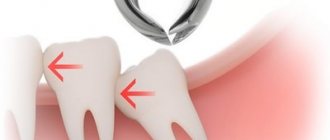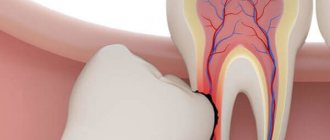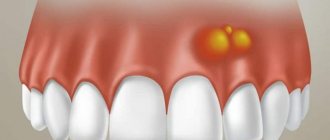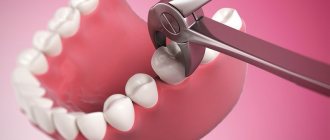Going to the dentist is always stressful for the patient. The main problem and fear before removal is pain. Modern technologies allow for painless removal, but this does not relieve patients from worrying about this problem. The wisdom tooth is rightfully considered one of the most difficult to remove, and therefore its painless removal is a real breakthrough in the field of dentistry. Specialists at the Zuub clinic perform wisdom tooth removal quickly, competently and without any pain.
Wisdom teeth - difference from other teeth
This tooth is no different from other molars in its structure. If it erupts without pain, does not cause discomfort to the person and has normal roots, then they do not get rid of it. Its cutting is often accompanied by acute or dull pain, lack of comfort when eating food and other unpleasant symptoms. The upper teeth can cause food stuck and damage to the mucous membrane, and the lower teeth can lead to the formation of a purulent hood, caries, etc.
The main differences are two factors:
- excessively curved or fused roots;
- the same curved root canals.
The first factor is reflected in the difficulty of extraction: the roots grow together and can have the most bizarre shapes. This is what causes the main difficulties for painless elimination. The second factor provokes difficulties with further treatment: canals of this shape are very difficult to subject to filling and mechanical stress.
Estimated cost of the procedure
According to the compulsory medical insurance policy, a tooth can be removed completely free of charge, in a state clinic. In private clinics, the procedure will cost from 1,500 to 3,000 rubles, depending on the degree of complexity. In some situations, the cost of the operation can even reach 15 thousand rubles or more, for example, with a complex extraction of the figure eight using sedation.
As for immediate recovery, the cost of such treatment using inexpensive brands will cost approximately 30-50 thousand rubles - this includes x-ray diagnostics, 3D planning and tests. Restoration with the installation of a more expensive Nobel Biocare implant and an adaptation crown will cost approximately 70-90 thousand rubles.
Category: Tooth extraction Published by Mister stomatolog
Difference between tooth extraction on the upper and lower jaw
If necessary, both upper and lower teeth are removed. Removing the upper wisdom tooth is somewhat easier, because the jaw on top is softer than on the bottom. The pliability of the bone in the upper jaw means that the removal of the upper wisdom tooth is carried out very quickly: it is easily “removed” from the row and leaves your mouth.
The lower ones can be curved towards the cheek or tongue. This is caused by the density of the bone tissue in the lower jaw. Plus, these teeth may not fully erupt or get stuck in the gum, causing pain and preventing the patient from opening his mouth wide. Simple removal of a wisdom tooth in the lower row requires local anesthesia and timely surgery.
How painful is it to remove upper teeth?
Today dentistry has all the capabilities to treat any complexity without pain and discomfort for patients. Even complex removal of the posterior destroyed element, including the figure eight, can be carried out quickly and completely painlessly. When working on the upper jaw, local anesthesia is usually sufficient. If desired, the patient can insist on the use of general anesthesia, for example, if he has a panic fear of dental treatment. Here you need to understand that the use of such powerful anesthesia has a whole list of contraindications and requires serious preparation.
An excellent alternative can be sedation, which involves placing the patient in a semi-conscious state. Fear and anxiety disappear, the person feels completely calm and relaxed, and can respond to simple requests from the doctor. It is noteworthy that after the sedation ends, the patient may not remember how the procedure took place. It should be understood that sedation is only an addition to pain relief and does not exclude the use of local anesthetics.
Simple and complex wisdom tooth removal
The operation for the upper teeth is performed in the “back” position, since a number of molars and the cheek prevent access to them. The main feature of removal in this case may be the strong curvature of the roots. To avoid complications, the dentist takes a photo and then proceeds to simply remove the wisdom tooth.
If the tooth has not fully erupted or is stuck, then the dentist will need to apply anesthesia, cut and open the gum. This operation is already called complex wisdom tooth removal. After these procedures, the doctor removes the crown and scrapes out the remains. After cleaning the socket and applying medication if necessary (for example, for bleeding), the doctor sutures the gum. This completes the complex wisdom tooth removal.
Removal is indicated for the following problems:
- inflammation of the mucous membrane;
- inflammation of the jaw bone;
- development of necrosis in soft tissues;
- formation of abscesses and hoods;
- the presence of a neoplasm in the form of a cyst;
- changes in the dentition and difficulties in the development of adjacent teeth.
Difference between simple and complex type
- Simple baby tooth extraction can be performed without anesthesia. Removal of the complex must be carried out after anesthesia.
- Duration. The simple procedure usually lasts from five to fifteen minutes. A complex surgical intervention can last from twenty minutes to an hour, and sometimes even take place in more than one stage.
- A simple tooth is removed with forceps and an elevator. The complex procedure requires special tools that may be needed to cut, lift the tooth, or saw through the root.
- After complex surgery, you may need to take antibiotics and anti-inflammatory drugs.
How painful is the surgery?
The use of modern equipment and special surgical equipment makes the task of removal easier for both the doctor and the patient. Painful sensations are eliminated by anesthesia. The injection is made by the dentist into the gum area. The injection itself is almost imperceptible and does not cause discomfort.
Wisdom tooth extraction can be sensitive for patients who have been taking pain medications for a long time. For particularly sensitive people, it is suggested to use either a repeat injection or a stronger anesthetic. More pronounced sensations can be observed in isolated cases in patients with an advanced abscess.
Painless surgery - complex or simple - is already a reality. The specialists of the Zuub clinic, thanks to the use of modern equipment and their accumulated experience, carry out operations efficiently and quickly. In such conditions, the patient can not only count on the absence of pain, but also complete comfort during removal.
Contraindications to the procedure
The extraction procedure (that’s what it’s officially called) has its limitations. It should be noted that almost all contraindications are relative, which means that after eliminating limiting factors, removal can be carried out. These phenomena and conditions include the following:
- acute infectious diseases,
- blood clotting disorders,
- first and last trimester of pregnancy,
- 2 days before and after menstruation,
- diabetes in an uncompensated stage,
- pathologies of the heart and blood vessels,
- mental illnesses in aggravation.
Sometimes emergency removal is required, and then there is simply no time left to eliminate the above-mentioned obstacles. In this case, the doctor takes on additional risk and performs the procedure as carefully as possible. It is better if it is a truly experienced and qualified dental surgeon.
Recommendations after removal
When the doctor has removed a wisdom tooth, he leaves a special tampon in the socket so as not to provoke the development of any infection. The patient should remove it after 5-10 minutes. You should not touch the hole itself with your tongue, finger or foreign objects. If you feel as if something is stuck in the socket after removal, you should contact your dentist. The doctor could have deliberately left a stash of medicine there for quick healing.
Prohibited after removal:
- Drinking alcohol.
- Drink and eat, especially hot food.
- Rinse your mouth - only make baths.
- Take a hot bath, steam in a bathhouse or sauna.
- Open your mouth too wide if the dentist has stitched it.
- Warm your cheek or face, because... swelling after removal tends to intensify.
If the patient does not follow the dentist's advice and violates the recommendations, the risk of developing oral complications increases. To prevent this from happening, you should strictly follow the doctor's instructions.
Recommended:
- Apply cold compresses.
- Take antibiotic medications if prescribed by your doctor.
- Make baths of soda and medicinal herbs, which are prescribed by the dentist.
- If your temperature rises after wisdom tooth removal, you need to take an antipyretic.
- Pain after wisdom tooth removal is relieved by taking painkillers prescribed by the dentist.
- Stick to a simple diet in the first days, i.e. do not eat hot foods, alcohol, fine-grained, viscous foods.
Description of the procedure: how it is carried out
If the patient is undergoing a planned operation, then first he is sent for an X-ray examination and tests. After studying the diagnostic results, the doctor begins the procedure or prescribes it for the next free time. Complex extraction is recommended to be carried out at the beginning of the day. It is better not to eat or drink immediately before visiting the doctor - this will help enhance the effect of the anesthetic. If the patient suddenly catches a cold before removal, it is better to reschedule the procedure.
First, the specialist administers anesthesia. If a simple operation is to be performed, its duration will be no more than 20 minutes. Using special forceps, the doctor carefully clamps the crown, rocks it with a special movement, and then sharply pulls it out of the socket. Lightly compresses the edges of the wound until the hole is completely filled with blood and a blood clot is formed - protection against infection and mechanical damage. Next, the doctor treats the injured tissue with an antiseptic, prescribes painkillers, and in some cases antibiotics, and gives detailed instructions about the postoperative period.
Complex extraction
The preparation stage here follows the same principle. A specialist is recommended to take an x-ray to determine root growth.
Is it painful to remove an upper wisdom tooth? After the anesthesia takes effect, the pain goes away and doctors begin surgery. It is carried out according to this scheme:
- the gum tissue is cut, after which it is peeled off from the bone;
- an area that is open (part or all of it) is cut out;
- The molar is removed, using an elevator or forceps;
- the hole is inspected to see if parts of the root remain;
- the wound is washed with antiseptic, anti-inflammatory solutions;
- the hole is stitched along the edges.
In what cases is it worth keeping the “eight”
Many people do not know what to do if caries is detected in a wisdom tooth, whether to save it or pull it out immediately. It all depends on the channels and its development. If the tooth has completely erupted, the canals are well passable, without curvature, then it is possible to fill it with high quality.
The third molars have a very important advantage, because of which they are trying to be preserved. Erupting later than the others, they are able to become a support for a bridge (instead of damaged teeth). Without them, such permanent prosthetics becomes possible only with the help of implantation of titanium pins. Also, third molars may be required for prosthetics if a person is missing the seventh tooth in front or both the sixth and seventh are missing.
Types of anesthesia
When a molar needs to be removed, anesthesia should be performed. There are three anesthesia options for this:
- local. Is it painful to have a wisdom tooth removed with this type of anesthesia? It is used most often. It acts in a specific area and relieves nerve endings of sensitivity;
- general anesthesia. Sometimes the patient does not have enough local anesthesia. Then anesthesia is used if the patient suffers from mental disorders, is terrified of surgery, and has a gag reflex. With such anesthesia, a person simply falls asleep;
- combined. Here, medications that promote relaxation and local anesthesia are simultaneously used. The patient remains conscious, but his emotional and physical levels decrease.
Is it painful to have a wisdom tooth removed? With high-quality anesthesia, you will not feel anything.
Indications and contraindications
Diagnosis of a complicated condition can also be characterized by associated negative factors, such as:
- The formation of tumors and edema, causing pain in the patient and affecting the structure of mucous tissues;
- Loss of sensitivity of the facial nerve endings caused by internal damage caused by the unnatural position of the root part;
- High probability of displacement or rotation of adjacent units in contact with the problem tooth;
- Diagnosis of pathological processes, the occurrence and development of which is caused by deviation of the alveolar position.
The price for removing a complex tooth in dental clinics in St. Petersburg also depends on the presence of medical contraindications that complicate or exclude surgical intervention. Limiting factors primarily include cardiovascular pathologies, insufficient blood clotting, a history of hypertensive crisis, acute forms of chronic and infectious diseases, as well as other manifestations that require additional treatment or the choice of an alternative method of recovery.











